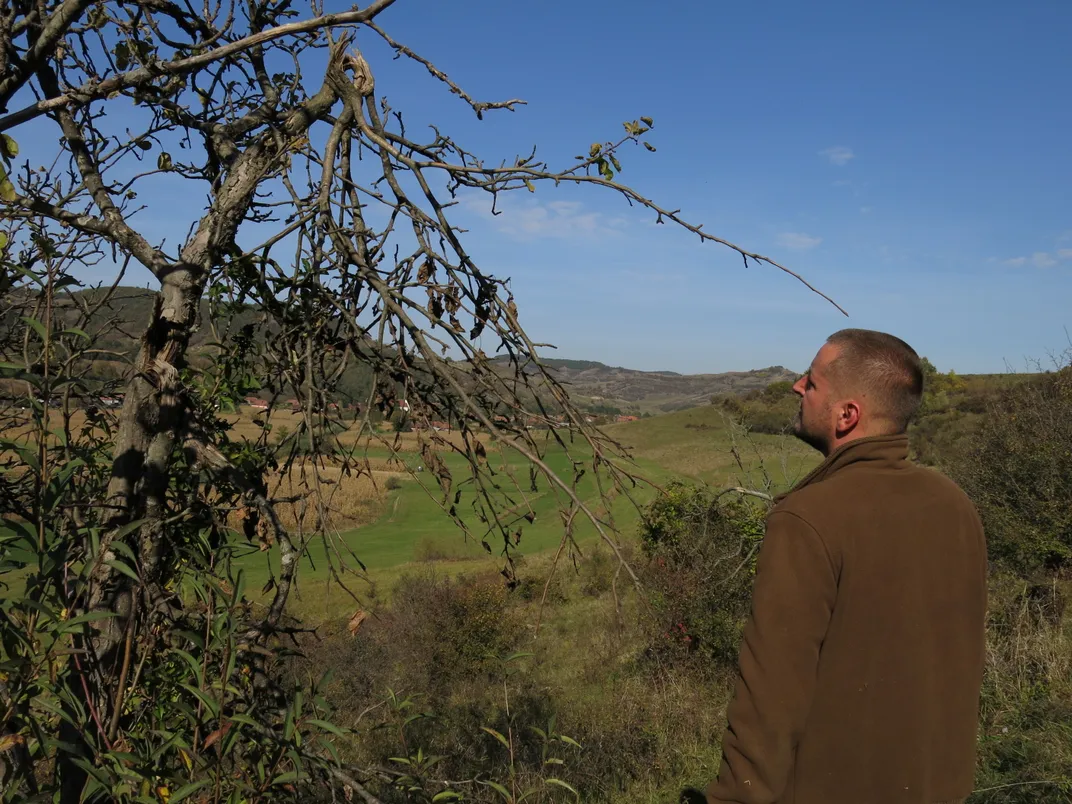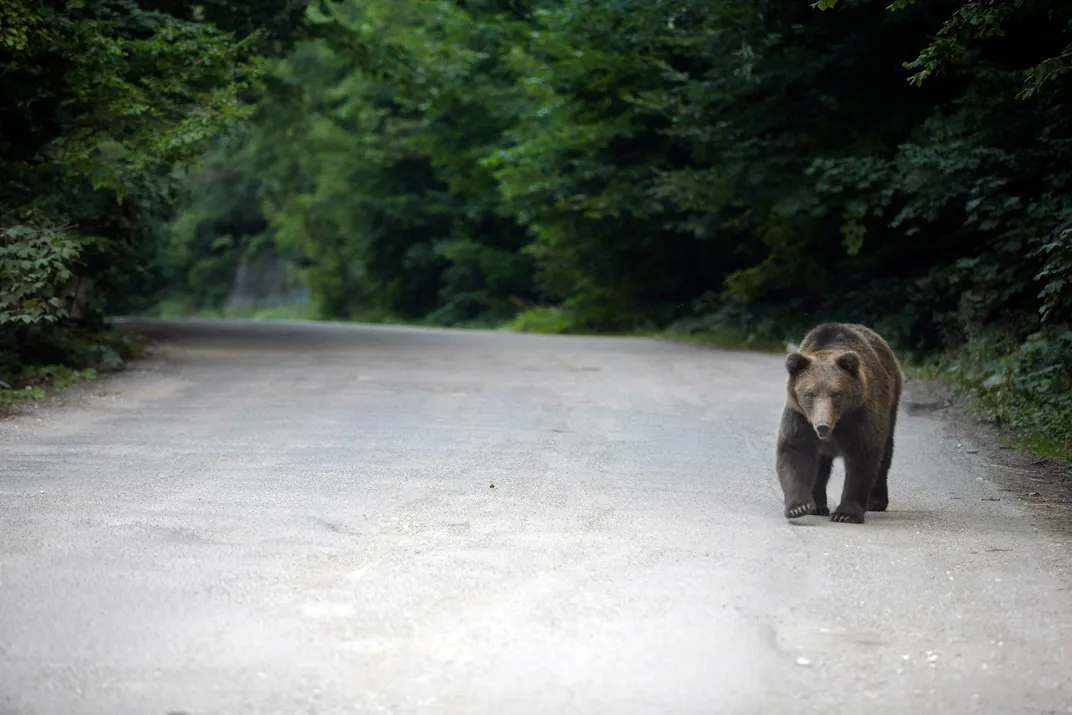The Deadly Dilemma Facing Romania’s Brown Bears
Around the Carpathian Mountains, frustrated farmers and high-paying sport hunters are helping to set the highest bear hunting quotas yet allowed
/https://tf-cmsv2-smithsonianmag-media.s3.amazonaws.com/filer/7d/12/7d12c4de-c63a-45a0-b1b3-76663d4bb23d/42-53068163.jpg)
According to the computer screen, a wild brown bear wearing a transmitter collar had entered a village in the Romanian mountains. The bear soon appeared in another village, prompting Csaba Domokos, a Romanian biologist with the environmental organization Milvus Group, to get on the telephone with a local hunting guide, who gave him the full story: A wealthy Danish sport hunter had shot the male bear on a legal hunt, then hauled the animal off to be skinned. The expensive collar had been removed and would be set aside for Domokos to come retrieve at his convenience.
Before it was killed, this bear had ranged over a vast territory and generated more than 3,700 location points in six months, Domokos says. It was expected to be an important animal for science. "I think this is a huge loss for [our] project … and it does feel like a personal loss to me," he said later over email.
That bear was just one of hundreds that could legally be hunted this season in Romania, where officials have granted more permits to shoot bears in the current season than they ever have before. While brown bears are strictly protected in the European Union, the law allows member states to cull an otherwise protected species if it threatens human safety and property. In the case of Romanian bears, the animals are frequently blamed for crop damage and dead livestock, and there have been fatal attacks on people.
So the Romanian Ministry of Environment, with EU approval, grants hundreds of permits every year to hunters hoping to bag a bear, a privilege that costs thousands of Euros. Hunters are led by guides, who beforehand place piles of fresh bait near "hides"—small, inconspicuous cabins in the woods where the hunter can wait for a shot. In some hunts, recruited assistants march through the forest, shouting and making a racket to usher bears toward the hunter, who waits, finger on the trigger. Sometimes hunters pursue their quarry from moving cars.
This fall, Romanian officials granted hunters 550 bear permits, up from 470 in 2013. In 2010, the quota was just 325. With other bears killed by vehicles and trains and still more targeted by poachers, who generally take just the hide and skull, scientists are concerned that Romania's bear numbers could dwindle if the population is not managed more conservatively.
Brown bears (Ursus arctos) are not internationally endangered, but in the EU they live in mostly small, isolated populations. Romania is an exception. More brown bears live here than in any other nation in the EU, with an estimated population of 5,000, mainly in the Carpathian Mountains and their foothills. Neighboring countries such as Bulgaria, Serbia and Ukraine only have several hundred bears each, while most nations further west have just a few dozen bears or none at all.
In a country that allows sport hunting of bears, accurately gauging the population is crucial—yet it's something that has not been done in Romania. While researchers like Domokos, who is tranquilizing bears and fitting them with GPS collars to track their movements, are helping to get a handle on the population, the numbers are still anything but precise. Some scientists have guessed there may be as few as 3,000 bears in Romania, while hunting organizations have made estimates as high as 10,000. Local hunting guides submit annual reports of bear-human conflicts to the Romanian Ministry of Environment, which uses the information to estimate the population. But hunting guides reap big money from the sport and so have incentive to inflate the numbers. The newspaper Balkan Insight reported in 2011 that hunting guides have exaggerated—and sometimes even falsified—the extent of bear-related damages to crops and livestock.
Worries also swirl that, in spite of a permitting system intended to cull "problem" bears, hunting guides are intentionally not targeting the right animals. Guides, after all, know that bears habituated to eating livestock, crops and trash are the very reason that EU officials allow them a hunting quota at all. If these hunting guides did their jobs as intended by pointing their clients toward the most problematic bears, they might successfully eliminate human-bear conflicts, says Ovidiu Ionescu, a brown bear specialist and professor at the Transilvania University of Brasov. But then they would also be out of work. So guides take hunters deep into the woods after trophy bears, leaving the dumpster-diving, crop-raiding bears to their business at the edge of town.
"The 'problem' bears represent only a small fraction of the culled bears," asserts Cristian-Remus Papp, with the Danube-Carpathian branch of the World Wildlife Fund. "The rest are the victims of the economical interests and the pleasure for killing massive animals."
Ionescu, who is also the head of a Romanian sport hunting organization, doesn't think hunting is driving the bear population down. Numbers are unnaturally large already, he says, thanks to a traditional (and perfectly legal) system of leaving out piles of corn for the animals at long-established bear viewing sites. Ionescu believes this food assistance program has boosted the population to 2,000 bears above the land's maximum carrying capacity, which he supposes is about 4,000 individuals. The bears, he says, need to be hunted.
Other experts argue that conflicts between people and bears have been unusually frequent this year, creating the illusion that bear numbers are escalating. Mihai Pop, a forest biologist with the Association for the Conservation of Biological Diversity, notes that this year both beech and oak trees produced abnormally poor crops, so the endlessly hungry bears, which rely on the trees' fruits, have turned en masse to domestic crops and animals. Pop also says that farmers didn't used to complain so loudly about bear-related losses. During the years of communism, he explains, such damages were considered a government issue, and farmers had less reason to report them. "But now losses are seen as personal, so people report the damages," Pop explains. "None of it means there are more bears now."
The other part of the equation involves figuring out how many bears die each year. Scientists estimate that a brown bear population can sustain a 10 percent annual kill rate without declining. A bear-hunting permit does not necessarily equal a dead bear, and most years, about two thirds of the Romanian hunting quota is fulfilled, according to Ionescu. But the toll taken by poachers is anyone's guess. While official documents estimate that poachers take about 20 bears each year, some scientists think that figure seems optimistic. Domokos has personally helped release five bears from poachers' wire snares this season alone. The most recent incident, in mid-October, involved a mother and cub caught in adjacent traps. Pop also believes undetected poaching could be taking a large number of bears.
Ensuring the long-term survival of bears in Romania will involve a better understanding of the population and curbing mortality. But Domokos says the most important step forward may be developing social acceptance of the bears. He has brought many schoolchildren into the mountains to see bear dens, bear tracks and other bear signs. His hope is to instill in them a fondness for one of Romania's most iconic animals.
But it may be harder to foster an appreciation of bears in the communities that suffer financial losses because of the animals. Pop hopes the past year's high rate of incidents between bears and farmers was an anomaly. He expects that if bear-inflicted damages return to lower levels next year, tempers currently hot with frustration may cool, and the government's hunting quota may even drop as a result.
"But if we have high damages again next year, people will be very upset with the bears, and there will be problems," says Pop.
/https://tf-cmsv2-smithsonianmag-media.s3.amazonaws.com/accounts/headshot/Off-Road-alastair-bland-240.jpg)
/https://tf-cmsv2-smithsonianmag-media.s3.amazonaws.com/filer/d7/27/d7277bb9-736a-4339-8c6a-21449010779e/bearattackwarningcrop.jpg)


/https://tf-cmsv2-smithsonianmag-media.s3.amazonaws.com/filer/24/4c/244cdcf0-daa1-4d4c-9ac0-9c29cf2e3c46/42-24305624.jpg)
/https://tf-cmsv2-smithsonianmag-media.s3.amazonaws.com/accounts/headshot/Off-Road-alastair-bland-240.jpg)